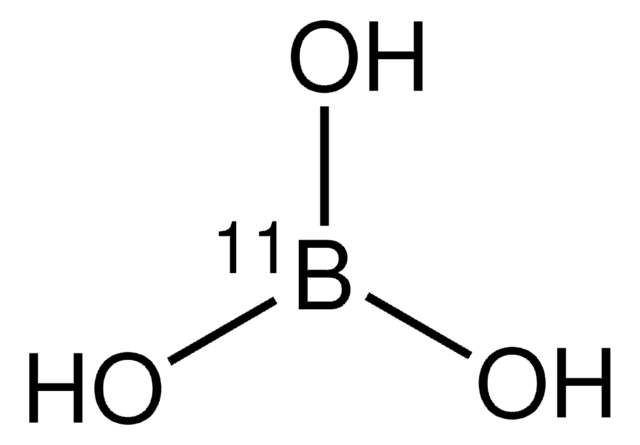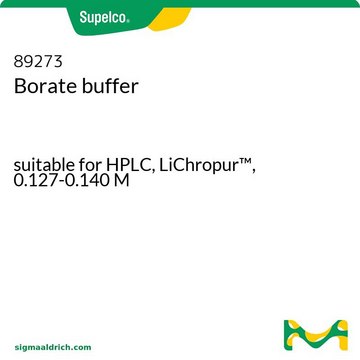All Photos(4)
About This Item
Linear Formula:
H3BO3
CAS Number:
Molecular Weight:
61.83
EC Number:
MDL number:
UNSPSC Code:
12352106
eCl@ss:
38120104
PubChem Substance ID:
NACRES:
NA.21
Recommended Products
Agency
suitable for SM 4500 - NH3
suitable for SM 5210
Quality Level
vapor pressure
2.6 mmHg ( 20 °C)
product line
ReagentPlus®
Assay
≥99.5%
form
powder
mp
160 °C (dec.) (lit.)
solubility
water: 40 mg/mL, clear, colorless
density
1.440 g/cm3
SMILES string
OB(O)O
InChI
1S/BH3O3/c2-1(3)4/h2-4H
InChI key
KGBXLFKZBHKPEV-UHFFFAOYSA-N
Looking for similar products? Visit Product Comparison Guide
General description
Boric acid is a weak monobasic Lewis acid (electron pair acceptor), which finds application in the areas of glass making, fire retardant, lubrication agent, buffer, neutron absorber, and adjuvant/excipient in pharmaceutical formulations.
Application
Boric acid can be used as:
- A catalyst to synthesize poly(δ-valerolactone) via bulk-ring opening polymerization.
- A ligand to synthesize metal-organic frameworks.
- A reagent in the preparation of borate buffer.
- A crosslinker to electrospun dextran nanofibers.
Legal Information
ReagentPlus is a registered trademark of Merck KGaA, Darmstadt, Germany
Signal Word
Danger
Hazard Statements
Precautionary Statements
Hazard Classifications
Repr. 1B
Storage Class Code
6.1D - Non-combustible acute toxic Cat.3 / toxic hazardous materials or hazardous materials causing chronic effects
WGK
WGK 1
Flash Point(F)
Not applicable
Flash Point(C)
Not applicable
Choose from one of the most recent versions:
Already Own This Product?
Find documentation for the products that you have recently purchased in the Document Library.
Debin Wang et al.
ACS nano, 8(8), 7896-7904 (2014-07-16)
Building plasmonic nanostructures using biomolecules as scaffolds has shown great potential for attaining tunable light absorption and emission via precise spatial organization of optical species and antennae. Here we report bottom-up assembly of hierarchical plasmonic nanostructures using DNA origami templates
Jihwan Lee et al.
Science advances, 6(43) (2020-10-25)
Unraveling the genetic and epigenetic determinants of phenotypes is critical for understanding and re-engineering biology and would benefit from improved methods to separate cells based on phenotypes. Here, we report SPOTlight, a versatile high-throughput technique to isolate individual yeast or
Jing Li et al.
American journal of physiology. Cell physiology, 306(10), C943-C960 (2014-03-22)
The human solute carrier (SLC26) family of anion transporters consists of 10 members (SLCA1-11, SLCA10 being a pseudogene) that encode membrane proteins containing ~12 transmembrane (TM) segments with putative N-glycosylation sites (-NXS/T-) in extracellular loops and a COOH-terminal cytosolic STAS
Hye Ryeo Lee et al.
Journal of chromatography. A, 1346, 117-122 (2014-05-09)
In liquid phase microextraction, high enrichment factors can be obtained using an acceptor phase of small volume. By hanging an acceptor drop at the separation capillary tip, single drop microextraction (SDME) can be in-line coupled with capillary electrophoresis (CE). The
Yona Goldshmit et al.
Oncotarget, 5(18), 8602-8613 (2014-09-28)
The three oncogenes, ErbB receptors, Ras proteins and nucleolin may contribute to malignant transformation. Previously, we demonstrated that nucleolin could bind both Ras protein and ErbB receptors. We also showed that the crosstalk between the three proteins facilitates anchorage independent
Our team of scientists has experience in all areas of research including Life Science, Material Science, Chemical Synthesis, Chromatography, Analytical and many others.
Contact Technical Service








